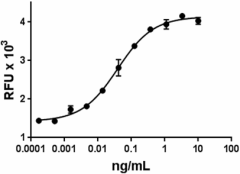- Regulatory Status
- RUO
- Other Names
- Il-1f11, Nuclear factor from high endothelial venules (NF-HEV)

-

Mouse IL-33 induces the proliferation of D10.G4.1 mouse T lymphocytes in a dose dependent manner. -

IL-5 induction by mouse IL-33 in splenocytes activated by anti-CD3 and anti-CD28. Data kindly provided Dr. Foo Y. Liew. -

Recombinant mouse IL‐33 induces proliferation in murine helper T lymphocyte (Th‐2) D10.G4.1 cells in a dose dependent manner. BioLegend’s product was compared side‐by‐side to the leading competitor's equivalent product.
| Cat # | Size | Price | Quantity Check Availability | ||
|---|---|---|---|---|---|
| 580502 | 10 µg | $206.00 | |||
| 580504 | 25 µg | $382.00 | |||
| 580506 | 100 µg | $938.00 | |||
| 580508 | 500 µg | $2578.00 | |||
IL-33 belongs to the IL-1 family and is closely related in structure to IL-18 and IL-1b. IL-33, IL-1b, and IL-18 are synthesized as biologically inactive precursor and are cleaved by the enzyme caspase-1 to be secreted as active mature forms. IL-33 stimulates target cells by binding to the IL-1R/TLR superfamily member ST2 and subsequently activates NF-κB and MAPK pathways via identical signalling events to those observed for IL-1b. In addition, IL-33 is a nuclear factor (NF-HEV) abundantly expressed in high endothelial venules from lymphoid organs that associates with chromatin and exhibits transcriptional regulatory properties.
Product Details
- Source
- Mouse IL-33, amino acids Ser109-Ile266 (Accession# AAH03847.1) was expressed in E. coli.
- Molecular Mass
- The 158 amino acid recombinant protein has a predicted molecular mass of approximately 17,554 Da. The DTT-reduced and non-reduced protein migrate at approximately 20 kDa by SDS-PAGE. The N-terminal amino acid is Serine.
- Purity
- Purity is > 98%, as determined by Coomassie stained SDS-PAGE.
- Formulation
- 0.22 µm filtered protein solution is in 20 mM HEPES, 150 mM NaCl, pH 7.2, 10 mM TCEP.
- Endotoxin Level
- Endotoxin level is < 0.1 EU/µg (< 0.01ng/µg) protein as determined by the LAL method.
- Concentration
- 10 and 25 µg sizes are bottled at 200 µg/mL. 100 µg size and larger sizes are lot-specific and bottled at the concentration indicated on the vial. To obtain lot-specific concentration and expiration, please enter the lot number in our Certificate of Analysis online tool.
- Storage & Handling
- Unopened vial can be stored between 2°C and 8°C for up to 2 weeks, at -20°C for up to six months, or at -70°C or colder until the expiration date. For maximum results, quick spin vial prior to opening. The protein can be aliquoted and stored at -20°C or colder. Stock solutions can also be prepared at 50 - 100 µg/mL in appropriate sterile buffer, carrier protein such as 0.2 - 1% BSA or HSA can be added when preparing the stock solution. Aliquots can be stored between 2°C and 8°C for up to one week and stored at -20°C or colder for up to 3 months. Avoid repeated freeze/thaw cycles.
- Activity
- ED50 = 0.0125 - 0.0625 ng/ml determined by the dose dependent stimulation of D10.G4.1 cell proliferation.
- Application
-
Bioassay
- Application Notes
-
BioLegend carrier-free recombinant proteins provided in liquid format are shipped on blue-ice. Our comparison testing data indicates that when handled and stored as recommended, the liquid format has equal or better stability and shelf-life compared to commercially available lyophilized proteins after reconstitution. Our liquid proteins are verified in-house to maintain activity after shipping on blue ice and are backed by our 100% satisfaction guarantee. If you have any concerns, contact us at tech@biolegend.com.
-
Application References
(PubMed link indicates BioLegend citation) - Product Citations
-
Antigen Details
- Distribution
-
High levels of mouse IL-33 mRNA are detected in the stomach, lung, spinal cord, brain, and skin. Expression within these organs is restricted to a few cell types, such as epithelial cells, fibroblasts, and smooth muscle cells. In addition, mouse IL-33 mRNA is found in resting dendritic cells and activated macrophages. Endothelial cells constitute a major source of IL-33 mRNA in chronically inflamed tissues.
- Function
- IL-33 drives production of Th2-associated cytokines from in vitro polarized Th2 cells. In mice, IL-33 injection induced the expression of IL-4, IL-5, and IL-13 and led to severe pathological changes in the lung and the digestive tract. In addition, IL-33 acts as a chemoattractant for Th2 cells, both in vitro and in vivo. TNF-α and IL-1β are activators of IL-33 transcription in fibroblasts and keratinocytes.
- Ligand/Receptor
- IL-33 binds to the IL-1 family receptor T1/ST2 and IL-1RAcP (IL-1 receptor associated protein)
- Biology Area
- Cell Biology, Immunology, Stem Cells
- Molecular Family
- Cytokines/Chemokines
- Antigen References
-
1. Schmitz J, et al. Immunity 2005 23:479-490.
2. Barksby HE, et al. C Exp Immunol 2007 149:217-225.
3. Arend WP, et al. ImmRev 2008 223:20-38.
4. Suzukawa M, et al. J. Immunol. 2008 181:5981-5989.
5. Moussio C, et al. PlosOne 2008 10:e3331. - Gene ID
- 77125 View all products for this Gene ID
- UniProt
- View information about IL-33 on UniProt.org
